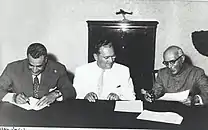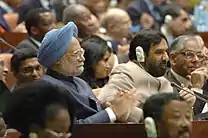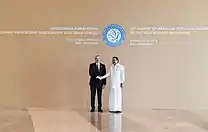India and the Non-Aligned Movement
For India, non-alignment conceptually started out as a policy of non-participation in the military affairs' of a bipolar world and in the context of colonialism, it did not mean passivity or neutrality and instead aimed towards optimum involvement through multipolar participation towards peace and security.[1] It meant that a country should be able to preserve a certain amount of freedom of action internationally. Without any set definition for what non alignment meant, the meaning of the term varied from statesman to statesman, situation to situation and country to county, making the phrase dynamic, evolving and relevant.[2] The overall aims and principles however found consensus among the movement members over time.[3] However, nonaligned countries could rarely attain the freedom of judgement they desired, their actual behaviour towards objectives of the movement such as social justice and human rights were unfulfilled in many cases, and in certain cases their actions, including that of India's, resembled the action of an aligned country.[4]
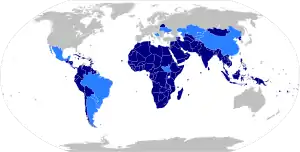
The response of the nonaligned during India's wars in 1962, 1965 and 1971 revealed nonaligned positions on various issues such as secession.[5] The non-aligned nations were unable to fulfil the role of peacekeepers during the India China war of 1962 as well as the Indo-Pakistan war of 1965 despite meaningful attempts.[6] The nonaligned response to the Bangladesh Liberation War and the following Indo-Pakistan War of 1971 showed that the concern of most of the nonaligned nations' territorial integrity came above human rights and genocide, a tilt that could be explained by the recently attained statehood for the nonaligned.[7] This was also a period when India's nonaligned stance was questioned and criticized.[8] Further, Nehru himself hadn't wanted the formalization of nonalignment and none of the nonaligned had commitments to help each other.[9] The international rise of other countries such as China also decreased incentives for the nonaligned countries to stand in solidarity with India.[10]
India played an important role in the multilateral movements of colonies and newly independent countries that wanted to participate in the Non-Aligned Movement. The country's place in national diplomacy, its significant size and its economic growth turned India into one of the leaders of the Non-Aligned Movement.[11]
Origin of non alignment in India
| Timeline |
|---|
|
Prior to Independence and India becoming a republic, Nehru grappled with the idea of India and the path it would take in the affairs of the world.[16] In 1946 Jawaharlal Nehru, as a part of the cabinet of the Interim Government of India, said during a radio broadcast "we propose, as far as possible, to keep away from the power politics of groups, aligned against one another, which have led in the past to world wars and which may again lead to disasters on an even vaster scale.[17] In 1948, Nehru made a speech to the Constituent Assembly (Legislative) titled "We Lead Ourselves" in which he commented that the world was going through a phase when the foreign policies of major powers had "miserably failed".[18] In the speech he talked about what alignment entailed among other things and what Indian delegates are told, "What does joining a bloc mean? After all it can only mean one thing: give up your view about a particular question, adopt the other party’s view on that question in order to please it […] Our instructions to our delegates have always been first to consider each question in terms of India's interest, secondly, on its merit - I mean to say if it did not affect India, naturally on its merits and not merely to do something or to give a vote just to please this power or that power [...]".[19] In 1949 in another speech to the Assembly he said, "We have stated repeatedly that our foreign policy is one of keeping aloof from the big blocs [….] being friendly to all countries... not becoming entangled in any alliances… that may drag us into any possible conflict. That does not, on the other hand, involve any lack of close relationships with other countries".[20] Some saw confusion in these constituent assembly speeches and the west questioned Nehru's "neutrality";[21] in United States in 1949 Nehru again tried to explain that "we are not blind to reality nor do we acquiesce in any challenge to man's freedom from whatever quarters it may come. Where freedom is menaced or justice threatened or where aggression take place, we cannot and shall not be neutral".[21] Over the years Nehru would make a number of comments on non alignment such as one in 1957 when he said, "Nonalignment seems to me as the natural consequence of an independent nation functioning according to its own rights. After all alignment means being regimented to do something you do not like and thereby giving up certain measures of independent judgement and thinking."[22]
Indian non-alignment was not only a product of the Cold War nor merely the result of a bipolar world.[1] For India, it had its origins in India's colonial experience and the nonviolent Indian independence struggle, which left India determined to be the master of its fate in an international system dominated politically by Cold War alliances and economically by Western capitalism and Soviet communism. In the words of Rejaul Karim Laskar, a scholar of India's foreign policy and ideologue of the Congress party which was the ruling party of India for the most part of the Cold War years, the Non-Aligned movement was the "formula" devised by Nehru and other leaders of the newly independent countries of the third world to "guard" their independence "in face of complex international situation demanding allegiance to either of the two warring superpowers".[23]
The term "Non-Alignment" was coined by V K Menon in his speech at UN in 1953,[24] which was later used by Indian Prime Minister Jawahar Lal Nehru during his speech in 1954 in Colombo, Sri Lanka. In this speech, Nehru described the five pillars to be used as a guide for Sino-Indian relations, which were first put forth by Chinese Premier Zhou Enlai. Called Panchsheel (five restraints), these principles would later serve as the basis of the Non-Aligned Movement. Jawahar lal Nehru was the architect of the Non-Alignment Movement. The five principles were: Mutual respect for each other's territorial integrity and sovereignty, Mutual non-aggression, Mutual non-interference in domestic affairs, Equality and mutual benefit and Peaceful co-existence. Jawaharlal Nehru's concept of nonalignment brought India considerable international prestige among newly independent states that shared India's concerns about the military confrontation between the superpowers and the influence of the former colonial powers. New Delhi used nonalignment to establish a significant role for itself as a leader of the newly independent world in such multilateral organisations as the United Nations (UN) and the Nonaligned Movement.
However Jairam Ramesh writes in his biography of Menon that neither Menon or Nehru "particularly cared for or were fond of the term 'non alignment' much less of the idea of 'non-aligned movement' or a 'non aligned grouping'."[24]
Early developments
The movement had its origins in the 1947 Asian Relations Meeting in New Delhi and the 1955 Asian-African Conference in Bandung, Indonesia. India also participated in the 1961 Belgrade Conference that officially established the Nonaligned Movement, but Jawaharlal Nehru's declining prestige limited his influence. In the 1960s and 1970s, New Delhi concentrated on internal problems and bilateral relations, yet retained membership in an increasingly factionalised and radicalised movement. During the contentious 1979 Havana summit, India worked with moderate nations to reject Cuban president Fidel Castro's proposition that "socialism" (that is, the Soviet Union) was the "natural ally" of nonalignment.
Nonaligned response to Sino-Indian conflict
The Sino-India war of 1962 was one of the first situations in which the non aligned countries faced a situation that was not directly related to the two blocs or issues such as colonialism.[25] The Belgrade Summit had been held in 1961 with representation from 24 countries. These 24 non-aligned countries reacted in different ways, from ignoring the situation or remaining mute to making low profile appeals and statements to "various shades of neutrality", there were full fledged attempts to mediate.[26]
...non-aligned nation(s) must be nonaligned with the non-aligned ... that is why, when some people here say, 'why haven't the non-aligned people stood up and shouted against China', I tell them, 'they have their own policy, they have their own independence'.
— V.K.Krishna Menon (1964)[27]
India... found non-alignment deteriorating into isolation. Even the other nonaligned leaders, with the honourable exception of Nasser and Tito were guarded in their response to India's case.
Nonalignment and Indo-Pak conflicts
The response of nonaligned nations in relation to the Indo-Pak conflicts revealed insights into their views towards self determination, issues of secession, the use of force in boundary disputes, armed intervention, external support in liberation struggles, human rights and genocide.[28][29] Many of the non aligned nations were facing similar issues in their own countries.[29] The 1965 Indo Pak conflict saw a continuation in the decline of the role of non aligned nations in a peacekeeping, a decline that started during the Indo Sino war with the failure to mediate.[6]
The 1971 war started out as an "internal issue" of Pakistan, an issue of human rights. This internal problem of Pakistan became India's internal issue with the migration of millions of refugees into India referred to as "civilian aggression".[30] Two major alignments developed, that of Pakistan, USA and China, and the other as India and the Soviet Union.[31] Without Soviet support, India would not have been able to hold its own against the Washington-Rawalpindi-Peking axis.[31] This polarization influenced all forums and international opinion, including that of the nonaligned which were 53 at the time.[31] While the nonaligned responses varied from calling the situation an internal matter of Pakistan to seeking a political solution to it being a humanitarian problem, none but one of the nonaligned states openly admitted the human rights aspect.[32] It took time for some of the non aligned nations to come to grips with the emergence of a new nation and to appreciate the contradictory issues of Pakistan national unity as opposed to the Bengali right to self-determination.[33] During the Uniting for Peace resolution nonaligned responses became clearer, with some of the African nonaligned being the most critical of India while others who wanted to stay neutral ended up making contradictory statements. The predicament of small nonaligned states was also seen.[34] India was disappointed with the nonaligned response. In August 1971, M.C.Chagla, a former foreign affairs ministers of India, said,[35][36]
"Look at the nonaligned countries, we have prided ourselves of our nonalignment. What have the nonaligned countries done? Nothing."
"...many countries have skeletons in their cupboard. They have minorities whom they have not treated well and they feel that if they support Bangladesh, these minorities will also rise in revolt, in rebellion, against the oppressive policies being pursued by the administration".
The signing of the Indo-Soviet Treaty of Friendship and Cooperation in 1971 and India's involvement in the internal affairs of its smaller neighbours in the 1970s and 1980s tarnished New Delhi's image as a nonaligned nation and led some observers to question India's nonalignment.[8]
Rather than an issue of non-aligned solidarity, India's declining influence in nonaligned areas as compared to the rise of China is also factored into the international pull away from support to India.[10] Also, there was no commitment for the non aligned to help each other, a view that Nehru himself had put forward. Nehru hadn't even wanted a formalization of the nonaligned.[37] Non-alignment had also affected India's bilateral relations with many countries.[37]
In 1980s
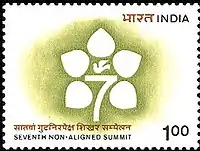
Under Indira Gandhi in the early 1980s, India attempted to reassert its prominent role in the Nonaligned Movement by focusing on the relationship between disarmament and economic development. By appealing to the economic grievances of developing countries, Indira Gandhi and her successors exercised a moderating influence on the Nonaligned Movement, diverting it from some of the Cold War issues that marred the controversial 1979 Havana meeting. Although hosting the 1983 summit at Delhi boosted Indian prestige within the movement, its close relations with the Soviet Union and its pro-Soviet positions on Afghanistan and Cambodia limited its influence.
The end of the Cold War left the Nonaligned Movement without its original raison d'être, and its membership became deeply divided over international disputes, strategy, and organisation. During the 1992 Jakarta summit, India took a middle position between countries favoring confrontation with developed nations on international economic issues, such as Malaysia, and those that favored a more cooperative approach, such as Indonesia. Although India played a minor role compared with Malaysia and Indonesia on most issues facing the summit, India formulated the Nonaligned Movement position opposing developed countries' linkage of foreign aid to human rights criteria.
21st century
In 2019, India was represented by the Vice President and External Affairs Minister at the 18th NAM summit.[14]
In May 2020, the Indian Prime Minister Narendra Modi participates in a NAM virtual summit.[15]
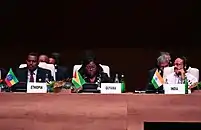
In July 2020 India's External Affairs Minister S Jaishankar said during an interview "non-alignment was a term of a particular era and a particular, shall I say, geopolitical landscape."[38][39][40]
See also
References
Notelist
- In 1979 the Havana Declaration was adopted to clarify the purpose of NAM: "the national independence, sovereignty, territorial integrity and security of non-aligned countries" in their "struggle against imperialism, colonialism, neo-colonialism, racism, and all forms of foreign aggression, occupation, domination, interference or hegemony as well as against great power and bloc politics."[13]
References
- Upadhyaya 1987, p. 11, Chapter 1.
- Upadhyaya 1987, p. 9, Chapter 1.
- Upadhyaya 1987, p. 5, Chapter 1.
- Upadhyaya 1987, p. 315–320, Chapter 6.
- Upadhyaya 1987, p. 301–302, Chapter 6.
- Upadhyaya 1987, p. 233, Chapter 4.
- Upadhyaya 1987, p. 295, Chapter 5.
- Upadhyaya 1987, p. 298, Chapter 5.
- Upadhyaya 1987, p. 302–303, Chapter 6.
- Upadhyaya 1987, p. 301–304, Chapter 6.
- Pekkanen, Saadia M.; Ravenhill, John; Foot, Rosemary, eds. (2014). Oxford Handbook of the International Relations of Asia. Oxford: Oxford University Press. p. 181. ISBN 978-0-19-991624-5.
- Upadhyaya 1987, p. 2.
- White, Nigel D. (24 October 2014). The Cuban Embargo under International Law: El Bloqueo. Routledge. p. 71. ISBN 978-1-134-45117-3.
- "Naidu, Jaishankar meet Afghan President on NAM Summit sidelines". ANI News. 26 October 2019. Retrieved 16 January 2021.
- Nagda, Ashutosh (11 May 2020). "India's Renewed Embrace of the Non-Aligned Movement". The Diplomat. Retrieved 16 January 2021.
- Grover 1992, p. 142, 151.
- Upadhyaya 1987, p. 2, Chapter 1.
- Grover 1992, p. 142, 147, Chapter 1.
- Grover 1992, p. 147, 150, Chapter 1.
- Grover 1992, p. 151, Chapter 1.
- Chary 1995, p. 59–60.
- Upadhyaya 1987, p. 13.
- Laskar, Rejaul Karim. "Respite from Disgraceful NDA Foreign Policy". Congress Sandesh. 6 (10): 8.
- Ramesh, Jairam (19 December 2019). "Part 1 Chapter 2". A Chequered Brilliance: The Many Lives of V.K. Krishna Menon. Penguin Random House India Private Limited. ISBN 978-93-5305-740-4.
- Upadhyaya 1987, p. 47-48, Chapter 2.
- Upadhyaya 1987, p. 66-76, Chapter 2.
- Upadhyaya 1987, p. 47, Chapter 2.
- Upadhyaya 1987, p. 168, Chapter 4.
- Upadhyaya 1987, p. 235, Chapter 5.
- Upadhyaya 1987, p. 251, Chapter 5.
- Upadhyaya 1987, p. 255, Chapter 5.
- Upadhyaya 1987, p. 264-270, Chapter 5.
- Upadhyaya 1987, p. 272, Chapter 5.
- Upadhyaya 1987, p. 272–275, Chapter 5.
- Upadhyaya 1987, p. 290, Chapter 5.
- Ghaṭāṭe, Narayana Madhava, ed. (1971). Bangla Desh: Crisis & Consequences: Proceedings of the Seminar, 7th and 8th August 1971. Deendayal Research Institute; [distributors: Indian Publishing House, Delhi]. pp. 83, 84.
- Upadhyaya 1987, p. 302–304, Chapter 6.
- Bhaumik, Anirban (20 July 2020). "S Jaishankar says era of non-alignment gone, as US, Indian warships conduct joint drills". Deccan Herald. Retrieved 10 January 2021.
- "EAM's interaction on Mindmine Mondays, CNBC (July 21, 2020)". Ministry of External Affairs, Government of India. 30 July 2020. Archived from the original on 20 July 2020. Retrieved 16 January 2021.
- Pant, Harsh V. "Gradually burying non-alignment". ORF. Retrieved 10 January 2021.
Bibliography
- Priyankar, Upadhyaya (1987). Nonaligned States And India's International Conflicts (Thesis submitted for the degree of Doctor of Philosophy of the Jawaharlal Nehru University thesis). Centre For International Politics Organization And Disarmament School Of International Studies New Delhi.
- Grover, Verinder, ed. (1992). Uno, Nam, Nieo, Saarc and India's Foreign Policy. Volume 10 of International relations and foreign policy of India. New Delhi: Deep and Deep Publications. ISBN 9788171003495.
- Chary, M. Srinivas (1995). The Eagle and the Peacock: U.S. Foreign Policy Toward India Since Independence. Greenwood Publishing Group. ISBN 9780313276026.
Further reading
- Gupta, Devender Kumar (1987). Role of India in Non-Aligned Movement: A Select Annotated Bibliography (submitted in partial fulfilment for the award of the degree of Master of Library Science) (PDF). Aligarh: Department Of Library Science, Aligarh Muslim University.
- Chaudhuri, Rudra. Forged in Crisis: India and the United States since 1947. Oxford University Press, 2014.
- "Library of Congress: Federal Research Division Country Profile: India, September 1995". Library of Congress Country Studies (All works are released in Public domain). Retrieved 6 November 2007.
